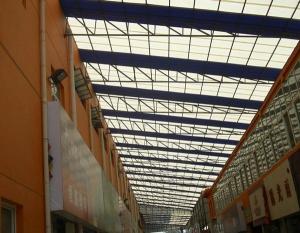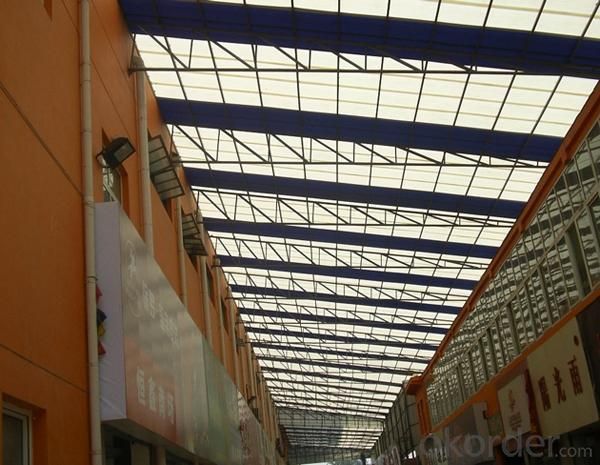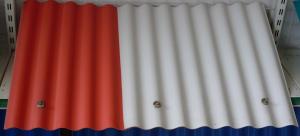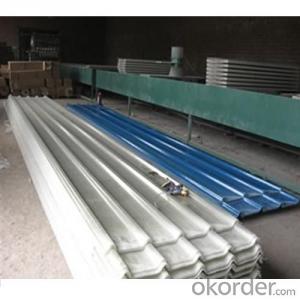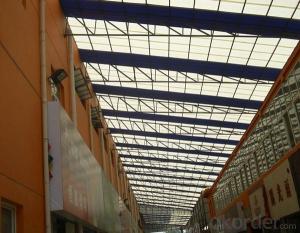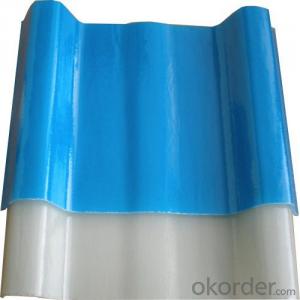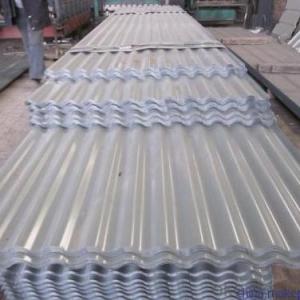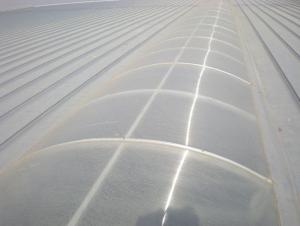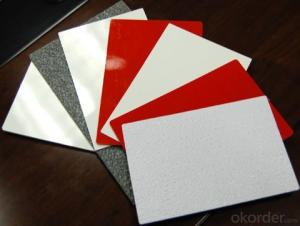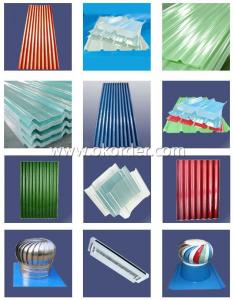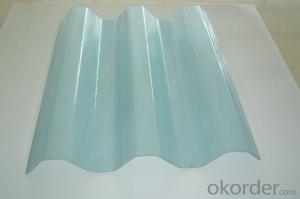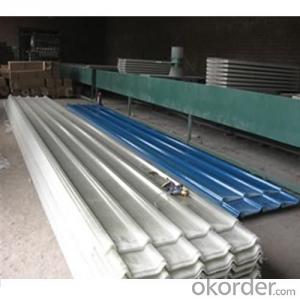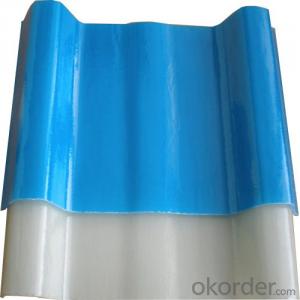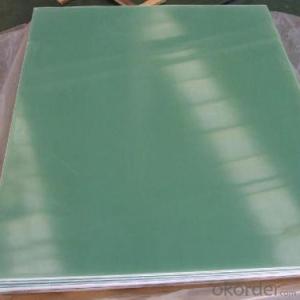FRP Roofing Panel S20
- Loading Port:
- China Main Port
- Payment Terms:
- TT or LC
- Min Order Qty:
- 100Pcs m.t.
- Supply Capability:
- 1000Pcs m.t./month
OKorder Service Pledge
OKorder Financial Service
You Might Also Like
Specification of FRP Roofing Panel S20:
Thickness:3.0mm
Color:sky blue, dark blue, clear, light green, dark green, opal, etc.
Ordinary Wave: 812-203
Length:No limit but with the consideration of transportation
Features of FRP Roofing Panel S20:
1) The fiberglass content of new generation greenhouse panel has been improved by 18.3%
2) Weather resistant and Self-clean ability
3) Excellent yellowness resistance
4) Strong impact resistant and low bending rate
5)Withstand extreme temperature from -38 degree to +110 degree for a long time
6) Aging resistant: specified F4 film added on surface and gel coat makes it endurable
for long.
7) More strengthened, safer, cleaner and more economical greenhouse panel.
8) Mainly serve the big factory, warehouse, super markets and other steel-structured project.
Packaging & Delivery of FRP Roofing Panel S20:
Packaging Detail: standard packing for export
Delivery Detail:3~7 days
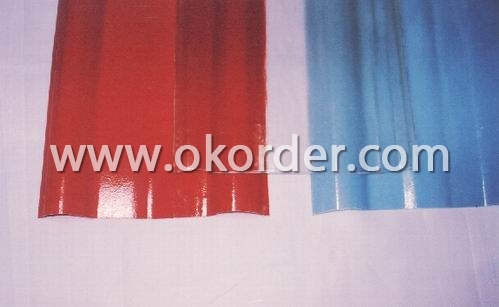
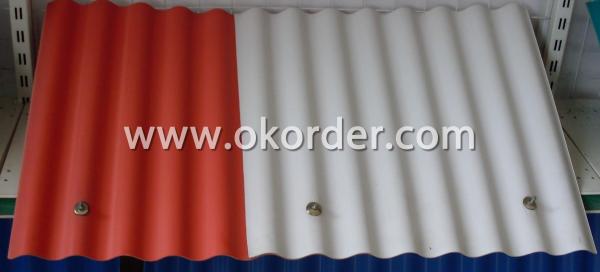
- Q: Do FRP roofing panels have any specific load-bearing capacity?
- Yes, FRP (Fiberglass Reinforced Plastic) roofing panels do have a specific load-bearing capacity. The load-bearing capacity of FRP roofing panels depends on various factors such as the thickness and composition of the material, the design and installation of the panels, and the specific application and intended use of the panels. FRP roofing panels are designed to withstand a certain amount of weight or load without experiencing deformation or structural failure. The load-bearing capacity of FRP roofing panels is typically determined through testing and evaluation by manufacturers or relevant industry standards. These tests assess the panels' ability to resist different types of loads, including static loads (such as the weight of the panels themselves, snow or ice accumulation) and dynamic loads (such as wind or seismic forces). It is important to note that the load-bearing capacity of FRP roofing panels may vary depending on the specific model or brand. Therefore, it is essential to consult the manufacturer's technical specifications or guidelines to determine the specific load-bearing capacity of the panels being used in a particular project. Additionally, it is advisable to engage the services of a qualified structural engineer or roofing professional who can assess the specific requirements of the project and ensure that the load-bearing capacity of the FRP roofing panels is adequate for the intended application. Taking these precautions will help ensure the safety and longevity of the roofing system.
- Q: Can FRP roofing panels be used for agricultural buildings?
- Agricultural buildings can indeed utilize FRP (Fiberglass Reinforced Plastic) roofing panels. The agricultural industry often favors FRP panels due to their durability, cost-effectiveness, and versatility. The strength-to-weight ratio of FRP roofing panels is well-known, as they are both lightweight and incredibly strong. This quality makes them applicable to a wide range of agricultural purposes, such as barns, livestock shelters, poultry houses, and storage facilities. In addition, FRP panels exhibit resistance to various environmental factors commonly found in agricultural settings. They are highly resistant to corrosion, UV rays, chemicals, and moisture, enabling them to endure severe weather conditions and the corrosive effects of animal waste and fertilizers. Furthermore, FRP roofing panels provide excellent insulation properties, creating a more comfortable environment for livestock and ensuring optimal temperature control within agricultural buildings. Additionally, they possess good light transmission properties, allowing natural daylight to penetrate the building and reducing the need for artificial lighting during the day. Moreover, the installation and maintenance of FRP panels are relatively straightforward. They are available in various sizes and can be easily tailored to fit the specific dimensions of the agricultural structure. The lightweight nature of FRP panels often leads to quicker installation and lower structural support requirements compared to alternative roofing materials. Regular cleaning to remove dirt and debris is generally the only maintenance needed to uphold the longevity and performance of the panels. Overall, FRP roofing panels serve as a dependable and practical option for agricultural buildings. Their durability, cost-effectiveness, and ability to withstand harsh environmental conditions make them a suitable roofing choice for farmers and agricultural businesses.
- Q: Are FRP roofing panels resistant to vandalism?
- Yes, FRP (Fiberglass Reinforced Plastic) roofing panels are generally resistant to vandalism. Due to their durable and strong construction, FRP panels are difficult to damage intentionally, making them a reliable choice for areas prone to vandalism.
- Q: Are FRP roofing panels suitable for commercial applications?
- FRP roofing panels are well-suited for commercial use. They are a popular choice for commercial buildings because of the many advantages they offer. Firstly, they are lightweight and durable, making them able to withstand harsh weather and heavy loads without compromising their structure. This makes them perfect for commercial buildings that require durability. Furthermore, FRP roofing panels are resistant to UV rays, corrosion, and chemicals, making them ideal for commercial applications where exposure to these elements is common. Their resistance also means that they require minimal maintenance, which lowers long-term costs for commercial building owners. Moreover, FRP roofing panels have excellent insulation properties, which helps with energy efficiency and reduces heating and cooling expenses for commercial buildings. This is particularly beneficial for commercial applications that require climate control in large areas. Finally, FRP roofing panels offer design flexibility, as they come in various colors, textures, and profiles. This allows commercial building owners to select a roofing system that meets their aesthetic preferences while still providing the necessary functionality. In conclusion, FRP roofing panels are an outstanding choice for commercial applications because of their durability, resistance to UV rays and chemicals, energy efficiency, low maintenance requirements, and design flexibility.
- Q: Do FRP roofing panels require a specific type of ventilation?
- Ventilation is a must for FRP roofing panels as it ensures their durability and performance. These panels tend to expand and contract due to temperature changes, so proper ventilation is necessary to prevent warping, cracking, or failure. To achieve this, ridge ventilation is the ideal option for FRP roofing panels. This involves installing ridge vents at the roof's peak to allow hot air to escape from the attic or space beneath the roof. By enabling a continuous flow of air, ridge ventilation prevents the accumulation of heat and moisture, which can be detrimental to the FRP panels. Alongside ridge ventilation, it is essential to have adequate soffit or eave vents to allow fresh air to enter the attic or space beneath the roof. This balanced airflow helps regulate temperature and moisture levels, providing further protection for the FRP roofing panels. It is important to note that specific ventilation requirements may vary based on the manufacturer's recommendations or local building codes. Hence, referring to the manufacturer's guidelines or seeking professional advice is advisable to ensure optimal performance and longevity of the FRP panels.
- Q: Can FRP roofing panels be used for walkways or catwalks?
- Yes, FRP (Fiberglass Reinforced Plastic) roofing panels can be used for walkways or catwalks. FRP panels are lightweight, durable, and have excellent strength properties, making them suitable for various industrial and commercial applications, including walkways and catwalks. These panels are resistant to corrosion, chemicals, and UV rays, making them ideal for outdoor use. Additionally, FRP panels can be customized to fit specific design requirements, making them versatile for different walkway and catwalk installations. Overall, FRP roofing panels are a cost-effective and reliable option for creating safe and functional walkways and catwalks.
- Q: Do FRP roofing panels require a specific type of roof anchor or tie-off system?
- Yes, FRP roofing panels typically require a specific type of roof anchor or tie-off system. These systems are designed to securely fasten the panels to the roof structure, ensuring their stability and preventing any potential damage or accidents.
- Q: Do FRP roofing panels require a specific type of fastening system?
- Yes, FRP (Fiberglass Reinforced Plastic) roofing panels typically require a specific type of fastening system. These panels are lightweight, flexible, and prone to expansion and contraction due to temperature changes. Therefore, it is important to use a fastening system that allows for this movement while securely holding the panels in place. Common fastening systems for FRP roofing panels include stainless steel screws with neoprene washers or adhesive anchors, depending on the specific installation requirements.
- Q: Are FRP roofing panels suitable for modular buildings or prefabricated structures?
- Yes, FRP roofing panels are suitable for modular buildings or prefabricated structures. FRP (Fiber Reinforced Plastic) roofing panels are lightweight, durable, and highly resistant to corrosion, making them an ideal choice for these types of structures. They offer excellent structural integrity, energy efficiency, and can withstand extreme weather conditions. Additionally, FRP roofing panels are easy to install and maintain, making them a cost-effective and reliable option for modular buildings and prefabricated structures.
- Q: Can FRP roofing panels be customized in terms of size and color?
- Yes, FRP roofing panels can be customized in terms of both size and color. FRP stands for fiberglass reinforced plastic, which is a versatile material that can be easily molded and fabricated to meet specific requirements. In terms of size, FRP roofing panels can be manufactured in various lengths, widths, and thicknesses to fit the specific dimensions of a building or project. Additionally, FRP panels can be custom-made in different colors to match the aesthetic preferences or branding requirements of the customer. The customization options for FRP roofing panels make them a popular choice for a wide range of applications, from industrial and commercial buildings to residential projects.
1. Manufacturer Overview
| Location | Shanghai, China |
| Year Established | 1999 |
| Annual Output Value | Above US$ 300,000 |
| Main Markets | Mid East; Eastern Europe; North America |
| Company Certifications | ISO 9002:2000 |
2. Manufacturer Certificates
| a) Certification Name | |
| Range | |
| Reference | |
| Validity Period |
3. Manufacturer Capability
| a) Trade Capacity | |
| Nearest Port | Shanghai |
| Export Percentage | 41% - 50% |
| No.of Employees in Trade Department | 100 People |
| Language Spoken: | Chinese |
| b) Factory Information | |
| Factory Size: | Above 100,000 square meters |
| No. of Production Lines | Above 5 |
| Contract Manufacturing | OEM Service Offered; Design Service Offered |
| Product Price Range | Average |
Send your message to us
FRP Roofing Panel S20
- Loading Port:
- China Main Port
- Payment Terms:
- TT or LC
- Min Order Qty:
- 100Pcs m.t.
- Supply Capability:
- 1000Pcs m.t./month
OKorder Service Pledge
OKorder Financial Service
Similar products
Hot products
Hot Searches
Related keywords
